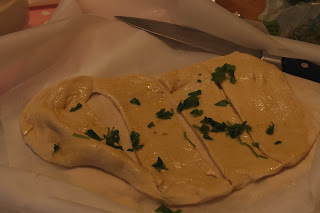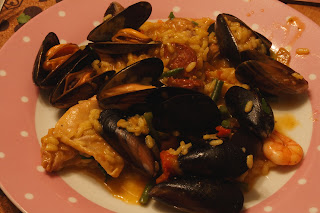I tend to be rather compulsive with food and yesterday was
just such an example. A couple of years ago I somehow acquired* Jamie Oliver’s
Jamie’s Italy recipe book and yesterday afternoon I was sitting in my garden
perusing it, enjoying the little bit of sun that was out and decided that I
MUST have homemade pizza for dinner.
Now, I didn’t think this would be too much of a problem. I
have all the stuff for bread making at home as it’s a new hobby of mine, I just
needed some toppings and semolina flour. Oh…and a pizza stone. Every book,
recipe, blog, article, person, chef (you get the picture?) says that cooking
pizza without a baking stone will just be a disappointment. I’m not really up
for disappointment in the kitchen, it rarely happens and it’s just such a waste
of food, but a pizza stone seemed to a nonstarter. I called every shop in the
area that I could reach before it closed but no, I googled how to make your own
pizza stone and called every DIY store I could find, but I couldn’t even get
hold of quarry tiles. I was getting to breaking point, questioning the advice
and wondering if I should just do it straight on the oven shelf when I wondered…
Eureka! How to make a pizza stone at home without buying any
new fangled toys…you just turn over a ceramic oven dish. Now, I’m still looking
to invest in some quarry tiles/pizza stone but for now this has done nicely.
I think I have rambled on enough now so here it is…
Pizza Dough courtesy of Jamie Oliver
Ingredients
800g strong white bread flour
200g semolina flour
1 tablespoon of sea salt
2 x 7g sachets dried yeast (I used fast action)
1 tablespoon caster sugar
Approx. 650ml tepid water
Baking stone/quarry tiles/upside down ceramic oven dish
Pour the flours, salt and (if using fast action dried yeast)
yeast and sugar onto a clean surface. If your yeast is just normal dry yeast
then you’ll need to put the yeast and sugar in warm water and leave for a few
minutes to froth. You must make sure the salt and yeast don’t directly meet at
this point. Make a well in the centre of the flour and pour in some of the
water. Using a fork start mixing the flour with the water to a dough. Keep adding
the water until it all comes together to form a ball (you’ll need to do that
bit with your hands).
Then comes the kneading. This is the crucial process in bread making and you really can’t skimp on it. At least 10 minutes is required and you’ll notice how much more stretchy and elastic the dough becomes. Once kneaded, flour the top, cover and leave to rest for 15 minutes (this is when I made my tomato sauce).
Divide the dough into as many pizzas as you want (I made 8
out of it, remember the size of the stone/dish you will be cooking it on, you
don’t want the pizzas to be bigger) and roll out the dough. I found to get it
thin enough I had to really stretch it with my hands after using a rolling pin.
Stack up on oiled and floured foil or baking paper (I might have forgotten the
flouring and oiling step…it made my life quite difficult by the end!) and they
are ready for toppings.
Basic pizza sauce
This sauce is so easy and can be made whilst the pizzas are
resting. This is enough to cover the dough and a bit.
Ingredients
Extra virgin olive oil
3-4 cloves of garlic
Fresh basil leaves
Fresh (or dried) oregano
2 tins (400g) good peeled plum tomatoes unfortunately I would have to say this is a time where basics tomatoes
won’t really do.
Salt and pepper
Heat a saucepan and add a glug of olive oil and the garlic
and cook until garlic is turning golden. Then add a small handful of basil
leaves and some oregano (I used about half a teaspoon of dried oregano). Pour
in the tomatoes, season with salt and pepper and leave to bubble and reduce on
a medium heat. Stir occasionally to ensure its not sticking and mash up the
tomatoes with your spoon. After about 20 minutes it will be ready but it will
be happy bubbling away for some more time, especially if you add a little water
(half fill one of the tomato cans with water and swoosh it around to get all
the last bits of flavour out) when drying out.
Now comes the really exciting part. Top your pizza with
whatever you want; here are some of my favourites.
My favourite pizza: Pancetta, buffalo mozzarella and rosemary
Tomato-less and tasty: garlic bread base with mixed mushrooms (I like oyster and shitake), ricotta cheese, thyme and Parma ham
The ‘Giulia’ : Cook a simple margarita pizza, once cooked top with parma ham and rocket
Garlic Bread
Ingredients
2 cloves of garlic (at least)
Extra virgin olive oil
Rosemary
Salt and pepper
Preheat the oven with your stone (or makeshift stone) inside to its hottest temperature.
Chop the garlic and then mash in a pestle and mortar. If you
don’t have one of these chop very small and then use the back of a knife to
mash into a paste. Pour olive oil into the paste and spread onto a rolled out
piece of dough with your fingers (or, you know, a basting brush of sorts). Sprinkle on some rosemary (I know I used parsley here but its much nicer with rosemary),score
some lines across and pull apart slightly (maybe slightly less than me!)
Place onto pizza stone and cook until golden and crispy.
* I say acquired because I am certain i never purchased said book, its as if it grew in my book collection!












































